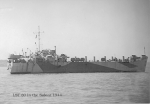NavSource Online: Amphibious Photo Archive
HM LST-80

LST-80 was turned over the United Kingdom for the duration of World War II
Please report any broken links or trouble you might come across to the Webmaster. Please take a moment to let us know so that we can correct any problems and make your visit as enjoyable and as informative as possible.

Royal Navy History Commissioned into the Royal Navy as HM LST-80, 19 July 1943 Assigned to the Royal Navy 9th LST Flotilla Believed sailed from New York in convoy UGS 15, 16 August 1943 Operated in the Mediterranean before returning to the United Kingdom At Falmouth February to March 1944 Participated in the Invasion of Normandy, June 1944 Operated in the shuttle service between London, Ostend and Antwerp Struck two mines while in convoy ATM97 off Ostend, Belgium and sank, 20 March 1945
| Click On Image For Full Size Image |
Size | Image Description | Source | |
|---|---|---|---|---|
 |
50k | HM LST-80 at anchor in the Solent, 1944. | Roger Smoothy | |
| Back to the Navsource Photo Archives Main Page | Back To The Amphibious Ship Type Index | Back To The Tank Landing Ship (LST) Photo Index |
| Comments, Suggestions, E-mail Webmaster. |
|
This page is created by David W. Almond and maintained by Gary P. Priolo |